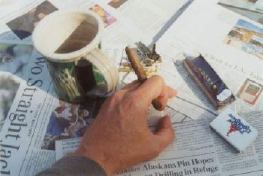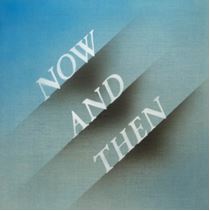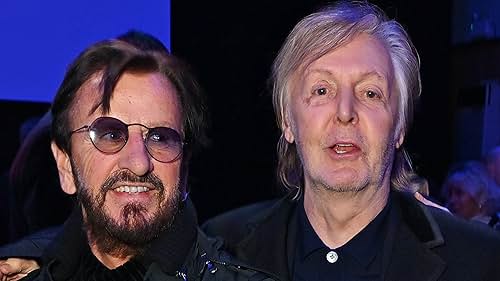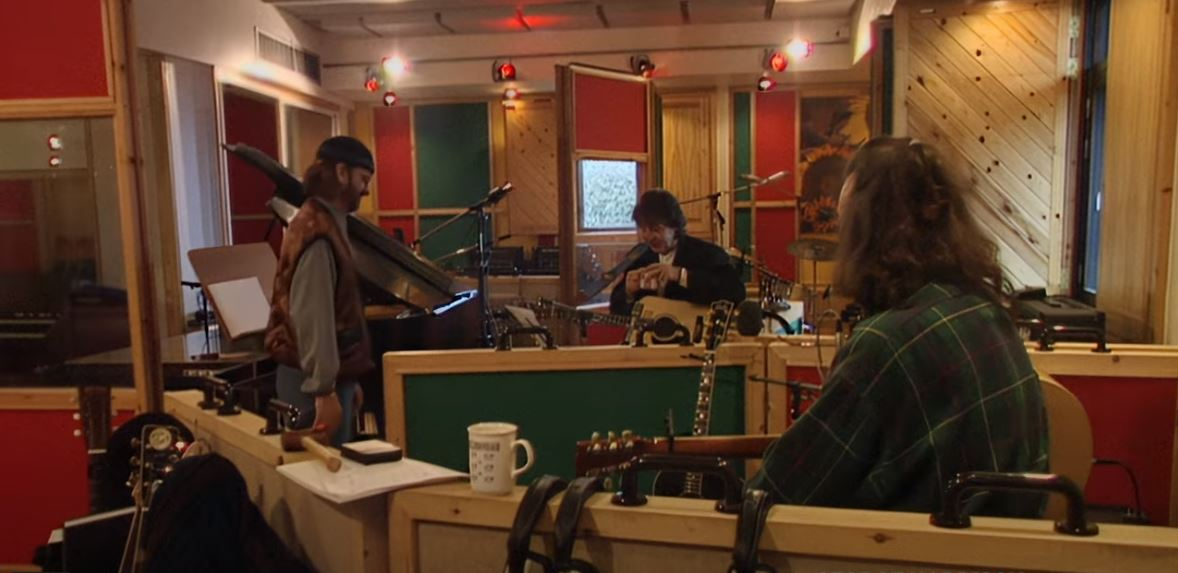RIPOSTE
by RIP RENSE
|

|
The Beatles' "Now and Then:"
time warp, or timely?
(Nov. 10, 2023)
It’s like walking
into the arena long after the concert ended, and seeing a
last few bits of confetti suddenly shake loose from the rafters.
Or perhaps, it’s more like visiting that arena fifty years after the
concert, and finding some old confetti in a corner, behind some boxes.
Then throwing it into the air.
I mean, whoever thought there would be a new Beatles song in 2023?
It’s like saying there is a new 1965 Mustang, a new Sean Connery James
Bond movie, a new outfit modeled by Twiggy, a new episode of “Batman”
with Adam West. In terms of surreal, this is up there with “I Am The
Walrus.”
Next thing you know, Ringo Starr will still be on the road with a band
at age 83, Paul McCartney will tour Australia at 80, and there will be a
new Rolling Stones album.
Oh,
wait. . .

A new
single! |

Sirs Ringo and Paul in 2023 |
Once upon a time, the world, or so it seemed, waited for new
Beatles songs the way dogs wait for walkies and kids wait for Christmas.
What would the next single sound like? How could they top “Lady Madonna”
or “All You Need is Love?” What? Paul is playing piano? What’s
happened to John’s voice? What’s with George and the India stuff? Ringo
is singing “Good Night?” I thought it was Paul!
There was absolutely no predicting the style or substance of Beatles
music---especially after 1965, when both started to drastically change.
Songs now long blithely accepted as mega-classics, such as “Day Tripper”
and “Yellow Submarine,” were shockers. Every single new tune was a
stylistic and creative revelation; like a new species of Beatles. The
anticipation and excitement? No more intense than sun spots. The mood,
the joy, the interest, the surprise . .it’s simply impossible to convey
to anyone from today’s culture, where (mostly commercially
contrived/demographically calculated) music “streams” like raging
for-profit rivers.
But it was more than just the explosive invention of The Beatles that
was at issue, as countless writers have noted over the decades. . .
In the ‘60’s, the world was in genuine fear of nuclear war.
Genuine fear. Soviet Union Premier Nikita Krushchev was on TV all the
time, interrupting after-school cartoons in a propaganda commercial,
yelling “We will bury you!” at the USA. Terrifying! Young men had to
worry about being yanked out of college and sent to die or be maimed in
Vietnam. Assassinations in the U.S. and abroad came to be frequent
news. News itself was just one TV half-hour a day (per each of three
networks), with local fare still in infancy; mighty newspapers still
defined information and discourse. Telephones? They were were plugged
into walls and dialed, took no pictures and had no “apps,” while mostly
black-and-white TV sets boasted seven stations (or less). “The Beverly
Hillbillies” and “Bewitched” were long-running hits. Seat belts in
cars were a new requirement, FM radio was still “experimental,"
and most people were (gasp) courteous (!). The country seemed to be
disassembling under anti-Vietnam protests, the civil rights
movement, the beat/Bohemian eco-ethos of hippies, the murder of Kennedys
and Martin Luther King, the fear and loathing
of Nixonian Republicans. There were three billion people in the world,
for God’s sake---not eight billion, as there are today (220 million in
the USA, as opposed to 330 million today.) Lines were short! You could
move around. You could breathe.
It is cliché to say that The Beatles became an unwitting antidote to all
the chaos, death, fear; a from-outta-nowhere medicine for
melancholy after the paralyzing assassination of President John F.
Kennedy. Country Having Nervous Breakdown, meet John, Paul, George,
and Ringo. Just hearing yeah yeah yeah after the oh, no
of November 22, 1963 was a very big deal---let alone you know it’s
gonna be all right during the tectonic tumult of 1968, what with the
killings of Martin Luther King, Robert F. Kennedy, and the riot that was
the Democratic convention. In just
eight years, the quartet seemed to evolve from exuberant, effervescent,
fluffy, Marx-Brothers-ian boys into hirsute philosophers resembling
nothing if not Aristotle, Leonardo, Swamis, even Christ. I mean, really
folks, you had to be there.
In short, in the ‘60s, a new Beatles song was an event.
And so it is again.
But is "Now and Then" a Beatles song, really? The old McCartney line about
why it would be difficult for The Beatles to reunite---“you can’t reheat
a souffle”---doesn’t apply, because some of the souffle ingredients
don’t even exist anymore. How, after all, do you make a Beatles song
with John Lennon, George Harrison, producer/arranger George Martin gone?
Let alone McCartney’s voice sounding a bit creaky? Here’s how:
You take the fourth Lennon homemade cassette recording given to “The Threetles” by Yoko Ono, “Now and Then,” in 1994. Yes, the
song that the
three worked on for just one day in 1995, adding try-out guitars and
vocals and drums. The one they discarded because the original tape had a
loud buzz on it, an echoey piano, and the sound of a TV set (some say)
in the background. You settle for doing just two Lennon-written reunion
songs, “Free as a Bird” and “Real Love,” and have done with “Now and
Then.” Until, that is, director Peter Jackson’s crew developed an
artificial intelligence program winkingly dubbed MAL 9000, in tribute to
The Beatles’ redoubtable assistant, Mal Evans (after “Hal 9000” in
“2001: A Space Odyssey) in order to separate Beatles voices from other
sounds while making the brilliant 2021 documentary, “Get Back.” And you
use this breakthrough program to separate Lennon’s voice from everything
else on that buzzy, cluttered mono 1977 home tape, then clean the
vocal up and give it studio quality fidelity. A miracle, really.
This is what happened. And lo and behold, the dormant old Beatles
engine somehow sputtered to life, even with a couple cylinders missing
and a clogged carburetor, for one last spin around the block.
Jump-started entirely by McCartney, who---as the “Get Back” doc
demonstrated---probably loved the group most of all. George’s acoustic
and electric guitars of the 1995 session were intact, and duly added to
the Lennon vocal. McCartney overdubbed a characteristically lyrical bass part, a piano, the "Because" harpsichord, and a Harrison-tribute slide guitar solo(!). Of course,
he called up the only other available Beatle in this world, Sir Ringo
Starr, for drumming duty---and to record background vocals
together.
Still, this gentle song of loss and longing really begged for the
cake-icing that was a George
Martin string arrangement. Voila! McCartney collaborated in writing one
with Martin’s producer son, Giles, and one Ben Foster. At last, in a
touch of characteristic Beatles whimsy, background vocals were
brilliantly mixed into the proceedings, taken from “Eleanor Rigby,”
“Here, There, and Everywhere,” and “Because.”
The result:
“It was incredibly touching to hear them working together,” said Sean
Ono Lennon, “after all the years that Dad had been gone. It’s the last
song my dad, Paul, George and Ringo got to make together. It’s like a
time capsule and all feels very meant to be.”
As for Harrison, who cancelled the original "Now and Then" sessions (and
who also rejected the Lennon reunion song, "Grow Old With Me," later recorded
by Ringo), Olivia Harrison said he would have
“wholeheartedly” joined the proceedings because of the MAL 9000
technology. And speaking of heart:
“It was the closest we’ll ever come to having him (John)
back in the room,” said Starr. “So it was very emotional for all of us.
It was like John was there, you know. It’s far out.”
For the inevitable critics who will dismiss “Now and Then” because it is
cobbled together from many sources and times and places, and that the
group did not record it together, well, such was the case with many of
the songs on the “white album" and "Abbey Road." Hardly disqualifying.
Is it above criticism? No. The song would have been stronger had
McCartney not excised Lennon’s original "I don't want to lose you"
bridge simply because it contained one line of scat-singing (which
actually sounded nice, or could have been replaced with a solo guitar
lick.) And Paulie really shouldn’t have imitated Harrison’s slide
guitar, when an actual Harrison solo could have been fashioned from
George’s solo work, beginning with his Grammy-winning double-lead guitar
instrumental, “Marwa Blues.” But as Lennon sang in “Dig a Pony,” you
can imitate everyone you know. . .
In the end, is “Now and Then” another brilliant, innovative
“Strawberry Fields Forever?” Or something simpler, in the vein of
“Julia” or “In My Life?” Certainly more the latter, as this is a fairly
straightforward, plaintive ballad from a period where a reflective,
semi-retired Lennon regularly
dabbled with song ideas at home in the Dakota. The song was probably
unfinished (Lennon’s songs often, if not usually, underwent many
iterations before the final take), and seems more like two or three song
ideas linked together. Yet they fit. And the chord changes are more of
the subtle minor key ilk that Lennon was developing toward the end of
his short life.
What is it about? This, of course, is up to the listener. McCartney has
noted that one of the last things, if not the very last thing, that
Lennon said to him during a phone conversation was, “Think of me every
now and then, my old friend.” So there is that private association for
him. For Yoko Ono, though, there was a very specific importance to the
song. She told me exclusively in 1995 that she gave “Now and Then” (she
referred to it as “I Don’t Want to Lose You”) to the other three for
“therapeutic reasons.”
“I thought this was a song which would release
people from their sorrow of losing John,” she told me. “By listening to
the song, they will eventually be able to release their sorrow, and
arrive at an understanding that, actually, John is not lost to them.
People who loved John are growing with John---by carrying their memory
of John in their hearts. Paul, George and Ringo lost a great friend as
well. If they sung this song from their hearts it would have helped many
people around the world who felt the same.”
This last Beatles song, as McCartney has declared it to be, is
entering a world almost as different from the ‘60’s as the 19th
century differed from the 20th. Technology, led by computers
and Internet, has destroyed and/or rearranged every bulwark aspect of
the culture alive in the sixties, in terms of social and economic
structure, and it has radically changed human behavior and sensibility.
Narcissistic preening and banality define much so-called popular
music; mayhem and ugliness infest movies and television; public
discourse has become crude, reactionary. Something as elegant as a new Beatles song today
seems not quite as out of place, alien, as a new
novel by Steinbeck, a new poem by Dickinson, a new symphony by Brahms.
And yet. . .assassinations then, assassinations now. Bellicose
Russian leaders then, bellicose Russian leaders now. Chaos in our
country then, chaos in our country now. Nuclear war threat then, nuclear
war threat now. Is The Beatles' "Now and Then" really so out of place
today?

The "Threetles" circa 1995, during the reunion
sessions. |
"NOW AND
THEN" WITH ORIGINAL BRIDGE
MORE ABOUT "NOW AND THEN"
RENSE'S ORIGINAL 2005 COVERAGE OF "NOW AND
THEN" IN WASHINGTON
POST
Copyright 2023 Rip Rense, all rights reserved
![]()